Tom Sarno is a forester by training who has been planting and cutting down trees his entire professional life. For the last 20 years, he’s been doing it for Manulife Investment Management and recently, the opportunity for a new kind of fund arrived.
As the global head of timberland investments, Sarno leads the world’s largest “natural capital” business, with nearly $15 billion in assets spanning six countries and almost 6 million acres. With a total area slightly bigger than the state of Vermont, that’s something like a Brookfield Asset Management of wooded areas. Like the alternatives firm that both owns and operates real estate, Manulife’s timberland group owns and operates forests. Its 450 employees include investment professionals and forestry technicians on the ground who protect and care for the trees.
For decades, the timberland group has helped private and institutional clients invest in the asset class for its diversification, inflation protection, and potential returns. The National Council of Real Estate Investment Fiduciaries’ Timberland Property Index, which tracks annual income generated and capital appreciation, is up 10 percent in 2023 and has an average annual return of 5.9 percent over the past 10 years and 7.2 percent over the past 20 years.
The traditional appeal of timber remains strong. But more governments, companies and organizations voluntarily — or under existing or future mandates — are trying to meet net emission goals and those efforts have created a burgeoning market for carbon credits. The current addressable market for voluntary carbon offsetting is around $2 billion annually in transaction volume. But it could grow to between $40 billion and $50 billion by 2030.
Manulife has created and sold carbon credits for years but it believeded a new fund could capitalize on the trend.
Late last year, it launched the first Manulife Forest Climate Fund whose objective is to mitigate climate change by buying, planting and sustainably managing timber forests while prioritizing carbon sequestration. It also has what Sarno described as a novel attribute: The carbon credits it creates will be available through direct in-kind transfers for investors’ own climate goals or can be monetized in the carbon markets via offset sales. “That is a very advantageous feature of the fund that we hypothesized would be well received. And that one certainly was,” Sarno said.
The fund and its affiliated offshore vehicles recently had its first close after getting up to $224.5 million in commitments towards the $500 million target.
The term of the fund is 12 to 15 years, which is short in a world where the prime age to harvest a tree might be 30 or older. But many investors interested were new to the asset class — they needed a defined window to help them determine how the fund fit in their portfolio.
Some investors have included timber in their allocations to infrastructure, private equity, real estate, if they don’t have a specific allocation to real assets.
That is a short time horizon for assets like timber and carbon. Most investments Manulife has done have timelines of 20 to 30 years. The fund “was trying to find that sweet spot for investors where we think we can be very competitive and very compelling in the market,” Eric Cooperström, managing director of impact investing and natural climate solutions at Manulife Investment Management, said.
Cooperström joined the firm almost three years ago to help develop the Manulife Forest Climate Fund and the firm expects it will be their first of many.
The carbon credit market is still facing challenges. Offsetting emissions has been touted as one of the best ways to combat climate change and as corporate interest in them has grown, the financial hustles surrounding them have proliferated. The carbon credit market is young, developing and imperfect. But it’s facing more scrutiny and improving. Manulife’s forests are certified under either the Sustainable Forestry Initiative or the Forest Stewardship Council and the frim says its vertically integrated business helps it ensure investors are getting what they were promised.
Voluntary carbon offsetting transactions of $2 billion don’t sound like much in the world of asset management, but that was four times as much compared to recent years. The momentum is real, Cooperström explained.
There are other tailwinds, too. Company investment and sustainability teams are interacting and collaborating more, which was historically uncommon. That means sustainable investments like timber are getting more attention.
“We’re starting to see the advent of people thinking about whether they should have a natural capital bucket,” Sarno said. “I don’t think anybody three years ago had a bucket for it, and I’m not sure how many do now, but that’s part of the discussion in their allocation. If they don’t have a specific bucket, they’re also thinking about the term natural capital and how much of that should they deploy and where it fits.”
Demand for wood products is also growing. There will always be the need for new homes and other structures, but electric cars, solar farms and other sustainable projects are all reliant on an expanding electrical grid and poles, which means they depend on big trees.
“This is the first of what we intend to be many natural climate-solution oriented vehicles,” Cooperström said. “We wanted to prove the concept and build on our track record and our in-house expertise and be able to successfully deploy the capital and that will certainly inform our future offerings.”







